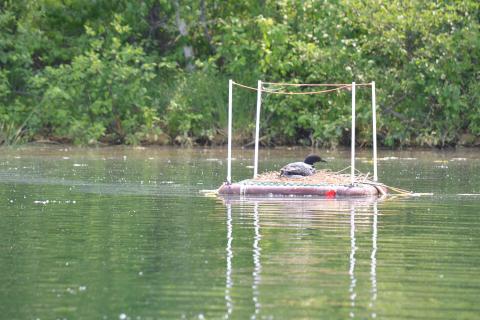When common loons returned this year to their Minnesota freshwater lakes for the summer breeding season, some of them found new homes waiting: artificial nesting platforms to help boost breeding success. These nesting platforms are provided by the Open Ocean Trustees’ Restoration of Common Loons in Minnesota project. This project addresses some of the injury to common loons caused by the Deepwater Horizon oil spill.
The Trustees worked prior to this nesting season with their local partner, the Minnesota Department of Natural Resources, to build and place 42 artificial nesting platforms. Deployed on the water, the platforms are covered with mud and aquatic plants to mimic the loons’ preferred nesting habitat. In their first year deployed, nesting pairs of loons used the platforms and hatched a chick. While this number seems low, it is comparable to first year results seen on similar projects.
These platforms provide additional sites for loons to build their nests leading to more potential offspring during the breeding season. There is an ongoing loss of suitable loon nesting habitat in Minnesota due to shoreline development, nest predation, and nesting failure caused by fluctuating water levels. Nesting platforms are one intervention that can increase loon breeding success and may help loon populations increase.
Common loons nest on North America’s freshwater lakes, but these “snow birds” head south to warmer waters when winter arrives. In April 2010, when the Deepwater Horizon oil spill occurred, many loons were still in the Gulf of Mexico and were affected by the oil spill.
Local community members, called Loon Liaisons, and 42 Minnesota Lake Association sponsors are active supporters of the restoration project. Loon Liaisons provide vital assistance with platform construction area surveys and placement; lake associations follow up by monitoring the platforms to see whether they are being used and whether any maintenance is needed.
The Restoration of Common Loons in Minnesota project was approved in March 2019 in the Open Ocean Trustees’ first Restoration Plan. Since then, the Trustees’ partners in Minnesota have surveyed lakes that were considered to produce fewer hatchlings compared to other lakes. Teams consisting of biologists from various organizations, members of the public, retired loon experts, and others observed the lakes to monitor loon use and productivity.
Common loon territories identified during this effort were then selected as control (no platforms) or treatment (placement of a platform) to allow for comparison and if platforms can increase loon productivity. This is just one aspect of a larger effort to reduce mortality and increase reproductive success of common loons in Minnesota. Another part of this project includes engaging the public in reducing the amount of lead potentially introduced into the loons' nesting lakes, and the purchase of land for loon nesting habitat. The estimated cost of the Restoration of Common Loons project is approximately $7.52 million.
We also send updates out via email. If you haven't already, please take the opportunity to sign up for e-mail updates today to receive the latest news from all the Deepwater Horizon Trustees.


